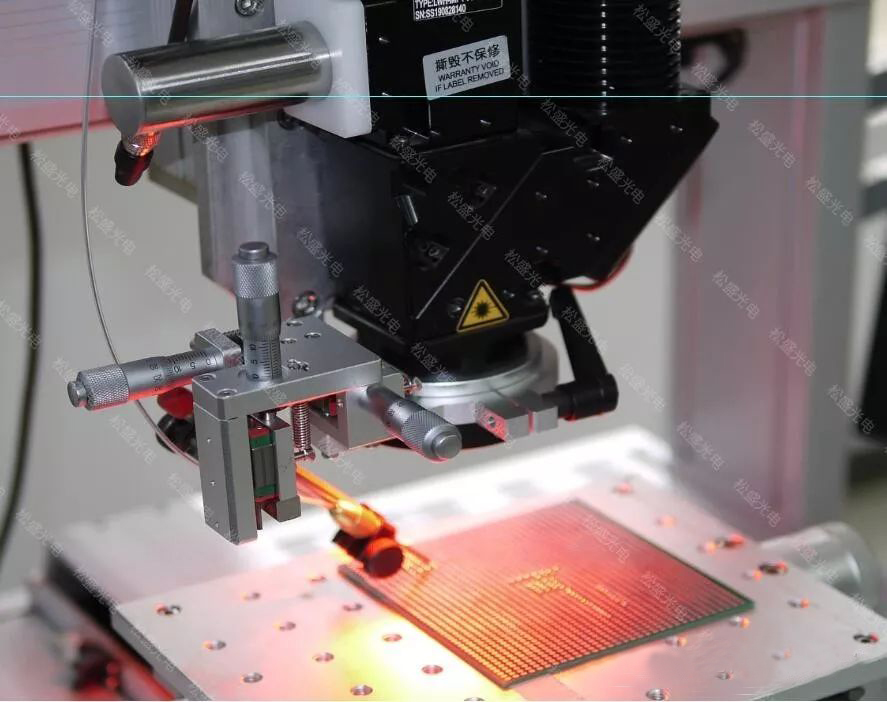Semiconductor Constant-Temperature Coaxial Laser Soldering Solution
Laser soldering technology has been applied in China for many years. The earliest solution was an upgraded version based on high-power laser penetration welding, using a direct semiconductor laser combined with a welding head (comprising laser collimation and focusing optical systems), along with an additional CCD camera for observation and positioning to replace traditional automated soldering irons. The main drawbacks of conventional soldering irons include the fact that soldering tips are consumables, with even high-end tips requiring replacement after approximately 20,000 solder joints. Each tip replacement necessitates CCD recalibration, which consumes significant time. In contrast, laser soldering is a non-contact process that eliminates wear on equipment components.
Laser soldering is a laser-based welding technology that uses laser as the heat source to heat pads and melt solder wire or paste to complete the soldering process. Its key characteristic is the use of laser's high energy density to achieve rapid localized or micro-area heating for soldering. Compared to traditional hot-air soldering and soldering iron methods, laser soldering offers the following advantages:

Single-Focus Welding Wire Feeding System
The laser processing offers high precision with a minimum spot diameter of 0.1mm, enabling soldering of micro-pitch mounted devices and chip components.
The short-duration localized heating minimizes thermal impact on the substrate and surrounding components. Different heating specifications can be implemented according to component lead types to achieve consistent soldering quality.
Eliminates the consumption of soldering tips and the need for heater replacement, enabling highly efficient continuous operation.
Laser processing provides high precision with micron-level laser spots. The processing time and power are program-controlled, offering far superior accuracy compared to traditional soldering irons. Welding can be performed in spaces smaller than 1mm.
Features six coaxial optical paths with CCD positioning for WYSIWYG (What You See Is What You Get) operation, eliminating the need for repeated visual alignment corrections.
Non-contact processing avoids stress caused by contact welding and eliminates static electricity issues.
Laser, as a green energy source, represents the cleanest processing method with no consumables required, simple maintenance, and easy operation.
Ensures crack-free solder joints when performing lead-free soldering.
When semiconductor laser is used as the heat source with fiber optic transmission, it enables processing in areas difficult to access by conventional methods. This approach offers excellent flexibility, superior focusing capability, and facilitates automation of multi-station equipment, among other advantages.

Laser Wire-Feed Soldering Process Flow:
The soldering method involves irradiating the target area with a laser beam → the irradiated surface generates heat → heat conduction raises the surrounding area to solder melting temperature → solder is supplied (solder paste is pre-applied).
Throughout the process from preheating to completion, the laser never physically contacts the workpiece, resulting in cleaner surface finishes. This non-contact approach enables precise soldering of miniature components that cannot be processed with conventional soldering iron tips.
While this solution achieves the aforementioned advantages of laser soldering—combining CCD positioning with non-contact laser soldering to address precision welding challenges, while the host computer control software regulates laser power output to prevent product damage or substrate burn-through caused by sudden power spikes—its cost-effectiveness makes it suitable for basic, low-end processing applications. However, its drawbacks are significant. Process development for each product typically requires incremental power testing from low to high levels to identify the optimal welding power for specific components. This process heavily relies on laser stability, yet market-available lasers often exhibit fluctuations that frequently lead to product burns or substrate penetration. For equipment manufacturers, these issues not only create relentless after-sales demands but, more critically, inflict irreparable damage to their reputational credibility—a far more devastating consequence than operational inconveniences.
Songsheng Optoelectronics began designing complete laser soldering solutions as early as 2013. Initially, we provided customers with optical components for the aforementioned solution. However, due to significant hidden risks in the laser systems of that solution, the company subsequently developed constant-temperature laser systems for users.
Through our self-developed fully enclosed five-channel coaxial welding head, we achieved real-time temperature detection at the laser processing point with internal closed-loop control. The system adopts PID algorithm between the laser power supply and the constant temperature control box, implementing a fully closed-loop control method. The temperature acquisition range spans from 100°C to 400°C, with regulation response time at 20 microseconds, avoiding control instability caused by manual PID parameter tuning.
Welding models can be built into the host control software to optimize control according to the welding models, achieving ideal soldering curves. Real-time online laser power monitoring ensures stable laser power output. Ultimately, this achieves high yield, high stability, and strong adaptability in online soldering applications.
Contact: Mr.Xiao
Phone: +86-13385280662
E-mail: market001@whlaser.cn
Add: Room 02, Floor 5, Building 9, Gezhouba Sun City, No. 40, Gaoxin 4th Road, Donghu New Technology Development Zone, Wuhan